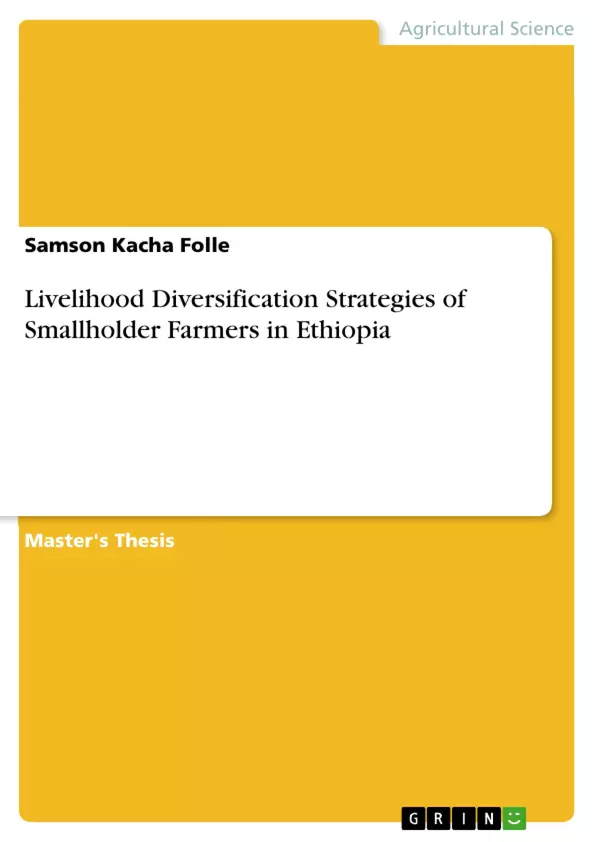This paper assesses the status of livelihood activities of smallholder farmers in Ethiopia and the need for diversification.
This study is motivated by the belief that the constraints of the farm sector cannot be overcome by simply concentrating on the farm sector alone; inter-sectoral issues and on farm and non-farm linkages need to be addressed. Primary data was collected from 140 households, out of which 75 were engaged in both on farm and non-farm activities and the rest (65 sample households) were engaged only in farm activities. Thus, to understand the stated objectives, primary data was collected using a validated semi-interview schedule, group discussions, a key informant interview, general observation, and scientific documents for secondary data. The collected data was then analyzed using descriptive and inferential statistical tools.
The economy of Ethiopia depends heavily on rain-fed agriculture. The sector is anticipated to hold up the whole economy and change its structure. However, the country is highly affected by drought and millions of people are left without sustenance every year. Therefore, diversified on farm and non-farm activities provide an important potential source of income for many.
Inhaltsverzeichnis (Table of Contents)
- Chapter One: Introduction
- 1.1 Background
- 1.2 Statement of the Problem
- 1.3 Research Questions
- 1.4 Objectives
- 1.4.1 General Objective
- 1.4.2 Specific Objectives
- 1.5 Significance of the Study
- 1.6 Scope of the Study
- 1.7 Limitation of the Study
- 1.8 Organization of the Study
- Chapter Two: Literature Review
- 2.1 Livelihood Diversification
- 2.1.1 Conceptual Framework of Livelihood Diversification
- 2.1.2 Factors Influencing Livelihood Diversification
- 2.1.3 Types of Livelihood Diversification
- 2.2 Non-Farm Livelihood Diversification
- 2.3 On-Farm Livelihood Diversification
- 2.3.1 Factors Influencing On-Farm Livelihood Diversification
- 2.3.2 Types of On-Farm Livelihood Diversification
- Chapter Three: Methodology
- 3.1 Study Area
- 3.1.1 Location and Climate
- 3.1.2 Socio-Economic Characteristics
- 3.1.3 Agricultural Characteristics
- 3.2 Sampling Techniques
- 3.2.1 Sampling Procedure
- 3.2.2 Sample Size
- 3.3 Data Collection Methods
- 3.3.1 Primary Data Collection Methods
- 3.3.2 Secondary Data Collection Methods
- 3.4 Data Analysis Techniques
- Chapter Four: Results and Discussion
- 4.1 Socio-Economic Characteristics of Households
- 4.2 Livelihood Diversification Strategies of the Households
- 4.2.1 Non-Farm Livelihood Diversification Strategies
- 4.2.2 On-Farm Livelihood Diversification Strategies
- 4.3 Factors Influencing Non-Farm Livelihood Diversification
- 4.4 Factors Influencing On-Farm Livelihood Diversification
- 4.5 Determinants of Household Income and Poverty
- 4.6 Discussion
- Chapter Five: Summary, Conclusions and Recommendations
Zielsetzung und Themenschwerpunkte (Objectives and Key Themes)
This thesis aims to investigate the prevalence of non-farm and on-farm production livelihood diversification strategies among farm households in the Adami Tulu Jido Kombolicha Woreda of East Shewa Zone, Oromia Regional State, Ethiopia. It seeks to understand the factors influencing these diversification strategies and analyze the impact of such strategies on household income and poverty levels.
- Livelihood Diversification Strategies
- Factors Influencing Livelihood Diversification
- Impact of Livelihood Diversification on Household Income and Poverty
- The Role of Non-Farm Activities in Rural Livelihoods
- The Importance of On-Farm Diversification for Agricultural Sustainability
Zusammenfassung der Kapitel (Chapter Summaries)
Chapter One provides an introduction to the study, outlining the research problem, objectives, and significance. It also details the study area, sampling techniques, and data collection methods. Chapter Two reviews relevant literature on livelihood diversification, non-farm activities, and on-farm diversification strategies. The chapter also explores the factors influencing these strategies and their impact on household income and poverty levels.
Chapter Three presents the results of the study. It analyzes the socio-economic characteristics of households in the study area, their livelihood diversification strategies, the factors influencing these strategies, and the impact of diversification on household income and poverty. Chapter Four discusses the findings of the study, drawing comparisons with existing literature and highlighting key implications.
Schlüsselwörter (Keywords)
This study examines the key concepts of livelihood diversification, non-farm activities, on-farm diversification, household income, and poverty in the context of rural Ethiopia. It investigates the prevalence, factors influencing, and impact of these strategies in a specific geographic region, drawing on empirical data and providing valuable insights into rural development policies and strategies.
- Arbeit zitieren
- Samson Kacha Folle (Autor:in), 2011, Livelihood Diversification Strategies of Smallholder Farmers in Ethiopia, München, GRIN Verlag, https://www.grin.com/document/1350374



